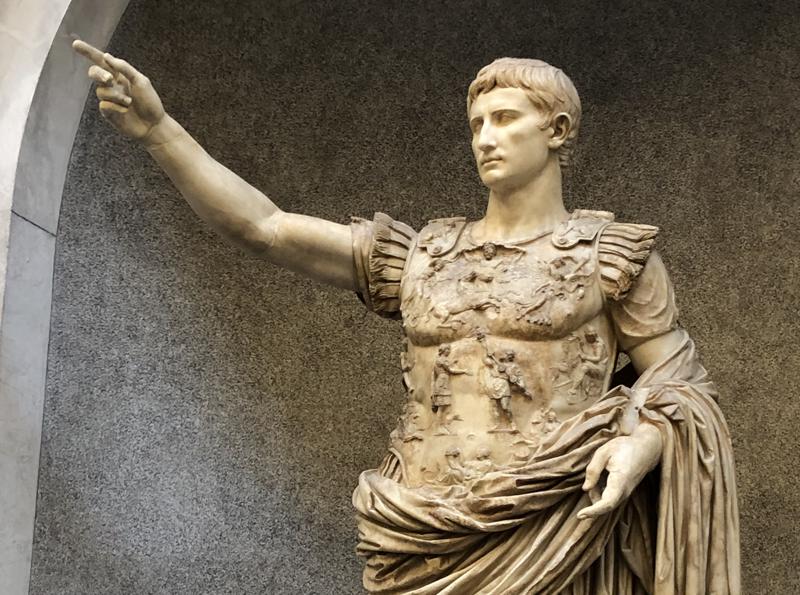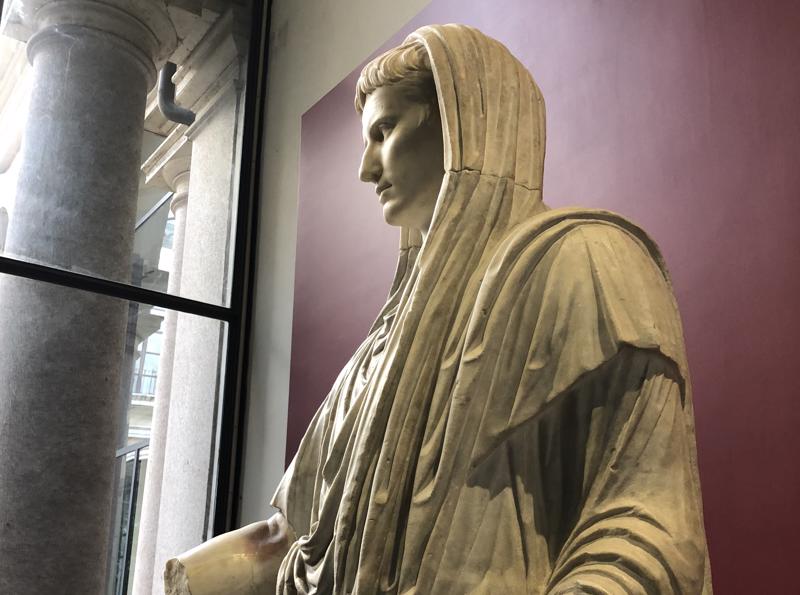Rome
Along with the Empire came its first emperor: Augustus. Augustus greatly increased the power and size of the empire in his years ruling, but had to be careful to keep the Roman people and Senate placated and unsuspicious of the power he gained. As illustrated by the two statues on the right, Augustus played two major roles in his position of power. The first is captured by the statue of Augustus of Prima Porta, which depicts Augustus in his role as commander of the Roman army, donning his armor and breastplate. Several aspects of the statue portray Augustus as a figure of power. For example, Cupid is at his side, reminding the Roman people of Augustus’s divine descent. He is also barefoot, which was often a way artists during that time depicted deities. However, Augustus is also draped with a toga, a clothing item typical of any Roman citizens, conveying the importance of military victories and extending Roman authority to protect and uphold Roman ideals. In the other statue, Augustus is in his priestly robes fulfilling his role as Pontifex Maximus. When Augustus put on these robes and made them part of his identity, he was also synthesizing Rome’s political and religious identity. One cannot help but draw the parallel between Augustus’s actions and Rome’s second king, Numa, who brought religious apparatus to Rome. Both pieces are clear propaganda, reinforcing the idea that Augustus is in charge of all
Emperor Augustus
January 14, 2019
|
Rome, Italy
Along with the Empire came its first emperor: Augustus. Augustus greatly increased the power and size of the empire in his years ruling, but had to be careful to keep the Roman people and Senate placated and unsuspicious of the power he gained. As illustrated by the two statues on the right, Augustus played two major roles in his position of power. The first is captured by the statue of Augustus of Prima Porta, which depicts Augustus in his role as commander of the Roman army, donning his armor and breastplate. Several aspects of the statue portray Augustus as a figure of power. For example, Cupid is at his side, reminding the Roman people of Augustus’s divine descent. He is also barefoot, which was often a way artists during that time depicted deities. However, Augustus is also draped with a toga, a clothing item typical of any Roman citizens, conveying the importance of military victories and extending Roman authority to protect and uphold Roman ideals. In the other statue, Augustus is in his priestly robes fulfilling his role as Pontifex Maximus. When Augustus put on these robes and made them part of his identity, he was also synthesizing Rome’s political and religious identity. One cannot help but draw the parallel between Augustus’s actions and Rome’s second king, Numa, who brought religious apparatus to Rome. Both pieces are clear propaganda, reinforcing the idea that Augustus is in charge of all


happenings in Rome as well as celebrating his accomplishments. These statues give insight on how the Roman people may have viewed their emperor and his power.
Share your travel adventures like this!
Create your own travel blog in one step
Share with friends and family to follow your journey
Easy set up, no technical knowledge needed and unlimited storage!